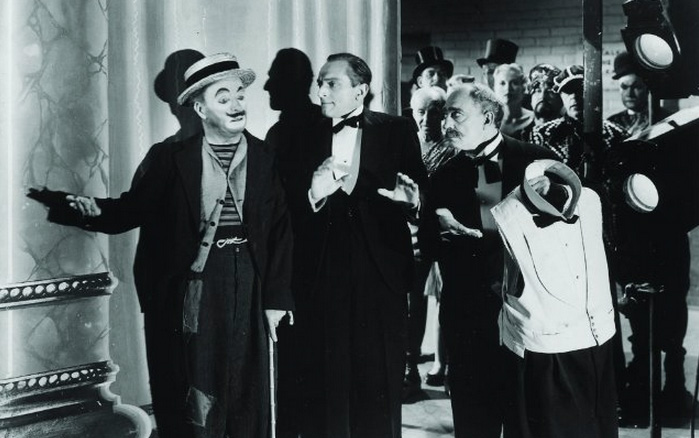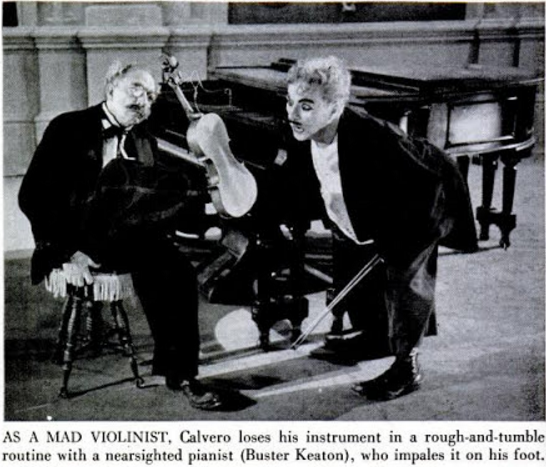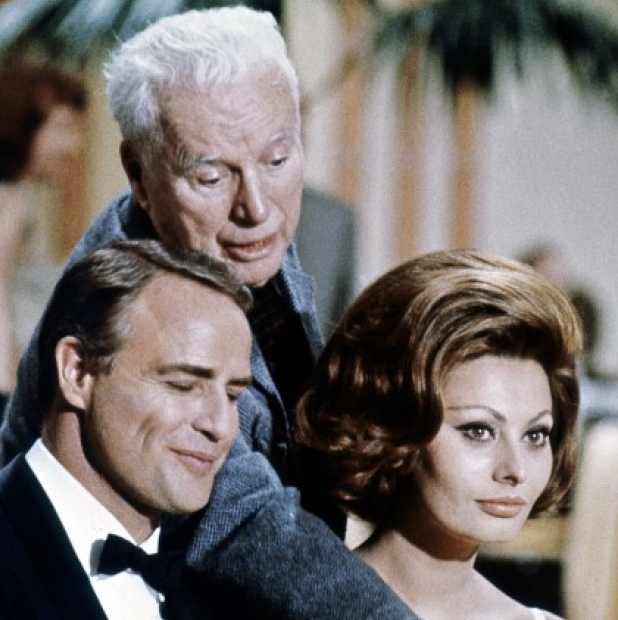Charlie Chaplin and Buster Keaton are the two most prominent figures of early movie comedies and they are often mentioned together as rivals for the “best silent comedian” post. Their relationship is an often-discussed topic and there are several theories floating around. Did they really feel threatened by each other? Or were they friends in reality as some others claim? There’s only one way to discover what is probably the closest to truth. Let’s take a look at this extraordinary relationship with the eyes of those who knew them.
Buster Keaton

Chaplin visiting the studio where Keaton was working in 1918. Probably one of their first meetings.
The audience thinks that we think in different channels. We automatically think in the same channel, but my way of doing it and Chaplin’s way are two different ways. (…) I’ve always been friendly with Chaplin socially. (…) We spoke the same language. I’ve changed gags with Chaplin – given him gags that didn’t fit me.”
Keaton remembered Chaplin fondly in his autobiography, even if it was written in a time when that wasn’t really the thing to do. He went on to describe Chaplin as the best comedian of all times until late in his life. However, Chaplin didn’t care to waste one single word on him in his autobiography.
Geraldine Chaplin
I remember once, he was then very old, and I came with a boyfriend of mine, very interested in cinema. Not so interested in Chaplin. He preferred Buster Keaton, which was not the thing to do. We arrived, and he spoke with my father a bit about silent films. And then he went on to talk about Buster Keaton, and my father just got smaller and smaller and he shrunk, and he was so hurt. It was like someone had stabbed him. And he just became very, very quiet. He didn’t say a word during dinner. And after dinner he was thinking and he was looking into the fire, and suddenly he peeped in a little voice. He looked at my friend in the eye and he said: “But I was an artist.” And no one knew what he was talking about. And then he said: “You know, I gave him work.”
A story told by Chaplin’s daughter, Geraldine in the wonderful documentary, Charlie: The Life and Art of Charles Chaplin.
Claire Bloom
Some of Keaton’s gags may even have been a little too incandescent for Chaplin because, laugh as he did at the rushes in the screening room, Chaplin didn’t see fit to allow them all into the final version of the film.
Limelight leading lady, Claire Bloom, implying that Chaplin didn’t leave all of Keaton’s best scenes in the movie. Later it became a popular urban legend how Chaplin cut out all of the scenes Buster shined in and left all of his best moments in the movie. This theory is often supported by the footage above that Buster Keaton recorded with Martha Raye (she appeared with Chaplin in Monsieur Verdoux) for television a couple of years later.
Jerry Epstein
There have been so many stories about Chaplin being jealous and cutting Keaton out of the picture. I’ve heard people on television stating that, “Oh, there was such marvellous stuff, but he cut it all out,” “Buster Keaton was funnier,” and all that business, which is a big, big lie. I just want to go on the record that it is not true. I was with him during the filming of it. He gave Buster Keaton such liberties to think of any gags. He wanted the best possible picture. (…) He did the best of Keaton and he gave him a lot by using the sheets of music falling down as counterpoint. Well, that was all done in one take. By his cutting, he gave Keaton an awful lot that wasn’t there just by repeating the same shot every time, and you scream with laughter!
Jerry Epstein, assistant director for the movie, one of the closest friends of Chaplin in his late life, was harsh at debunking the malicious gossips against Chaplin.
Eugène Lourié
Theirs was a friendly rivalry to see who would get the biggest piece of the pie. Buster would go very, very long in his takes. Chaplin would say: “Buster it’s too much – I think – don’t you?”
Eugène Lourié, Ukrainian-born French designer and director, who was one of Chaplin’s right-hand men during the production of Limelight, about the way Chaplin and Keaton worked together.
Melissa Hayden

A rare photograph, depicting Chaplin and Keaton in a scene that has never appeared in the movie.
When Chaplin was doing things with Keaton he was very intense. His whole personality changed from what it had been with me earlier in the day. I was amazed. That was the first inkling I had of what he was about.
Melissa Hayden was a Canadian ballerina, appearing as the dance double for Claire Bloom in Limelight.
LIFE Magazine, March 1952

The scene with Buster Keaton, himself a star of the silent comedies, began with only the meager idea of a nearsighted pianist and an acrobatic violinist. The two, who had never appeared together before, spent a day of preparation in shirtsleeves organizing the piece of business which would form their act. With utter disregard of their ages (Keaton, 56, Chaplin, 63), they danced and tumbled, experimented, repeated. Over and over Chaplin twirled, tripped, rolled across the footlights into the orchestra pit where worried grips stood by to catch him. Time and time again Keaton staggered from the wings, crashed awkwardly into the piano and fell to the floor in a flutter of music sheets. Stagehands, dancers, musicians sat in bemused groups breaking into laughter, applauding as they watched a show no one else would ever see.
The 11 pages long article, titled “Chaplin at Work”, explained Chaplin’s way of shooting Limelight. One paragraph revolved around the impressive event of two of the funniest men of the century working together.
 This article is part of the Third Buster Keaton Blogathon, hosted by Lea at Silent-ology. If you’re interested in other great posts about Keaton, who was born 100 years ago, just click here!
This article is part of the Third Buster Keaton Blogathon, hosted by Lea at Silent-ology. If you’re interested in other great posts about Keaton, who was born 100 years ago, just click here!
My sources: the regular Chaplin sources I use; chaplin.pl; LIFE Magazine, March 1952; Chaplin’s Limelight and the Music Hall Tradition; Buster Keaton: Interviews






Thank you for a most fascinating article. That there might be both conflict and camaraderie between two men so polished at their craft is to be expected. Ultimately, all that matters is the laughs.
LikeLike
I couldn’t agree with you more 🙂 Thanks for the nice words, too!
LikeLike
Author James Roots observes in his new book The 100 Greatest Silent Film Comedians that Charlie gave Buster essentially no material, and Buster was too respectful to make something out of nothing. James concludes wishing Harold Lloyd had been given the nod instead, as he would have injected bounce and energy into the bit, and given his equal (at least financial) standing with Chaplin, would not have been so differential. Never thought of it that way before.
LikeLike
That’s a really interesting thought, thanks for sharing it! I actually believe the best option would have been if all three of them had appeared in the scene 🙂 By the way, I just have to tell you I love your blog! You always come up with the most interesting pieces of informaion!
LikeLiked by 2 people
With much respect to Mr. Bengston, that is a terrible theory. Keaton was “too respectful to make something out of nothing”? What does that even mean? Creating something out of nothing was practically how those two men worked for much of their career. Is Roots suggesting that Keaton was not capable of great improvisation? Of course not, but he is also putting the blame on Chaplin. This is incorrect, as well. Regrettably, this is your standard film commentary short-cut: in order to praise Keaton, one must damn Chaplin. Despite what you have read, folks, Keaton and Chaplin were not mutually exclusive. You can like Keaton just. It’s all right. You don’t also have to tell me that you don’t like Chaplin’s ‘sentimentality’. I could give you a hundred reasons why the Beatles were the greatest band in history, without ever telling you that I dislike the Rolling Stones. Maybe Mr. Roots believes that Keaton was too good for Chaplin. That’s ok. And while Bengston is correct in saying Harold Lloyd was equal to Chaplin financially, the comparison ends there. Lloyd was not the ‘third genius’. Lloyd does not have a as-yet-undiscovered film comparable to”Gold Rush” or “the General” hidden in his body of work. The truth is much simpler; these two great men were just a couple years past their prime. But, you know, that’s all right, too, because Limelight is a fine film, even if it is not very funny.
LikeLike
Thank you for gathering all those descriptions of the two great men working together. I knew the first time I saw the scene with an audience that Chaplin had plenty of respect for Buster and let him get many laughs.
LikeLike
Thanks for your comment! I agree with you, they seemed like a great pairing in their scene together!
LikeLike
This was fascinating to read! I have not seen this film yet, but am quite eager to do so. Though I did watch their scene together on youtube, which was hilarious! 🙂
LikeLike
I’m so glad you like it! Though this is not Chaplin at his best, the movie most certainly has a great nostalgia-factor which makes it worth watching!
LikeLiked by 1 person
Hi there, GREAT contribution to the blogathon, thank you very much! Having these quotes all in one spot is very useful. There’s something monumental about seeing those two onscreen together, and you can only wish it had happened sooner in their careers (aside from the brief appearance in that 1920s SEEING STARS newsreel).
I totally side with those who argue that Chaplin wasn’t selfishly editing out Buster’s best gags. Having a side character suddenly steal all the spotlight wouldn’t make sense in the context of the film, and I’m sure Buster understood how much he was supposed to contribute. That Geraldine Chaplin quote has always fascinated me–Chaplin became somewhat arrogant later in life, but this certainly could’ve masked a deep, life-long insecurity.
LikeLike
Yes, you’re totally right, there’re some quite disturbing stories about Chaplin as an old man – I just wouldn’t have liked to be near him when he was being grumpy! Thanks for hosting the blogathon, I had huge fun 🙂
LikeLiked by 1 person
I enjoyed this article, Domi! I too believe that there actually was a healthy mutual respect and awe between the two great comic actors, despite whatever rivalry may have underlain their relationship! And like Lea, when I watch their routine in Limelight, it makes me wish they’d done more work together. Thank you for an enjoyable read.
LikeLike
And thank you for your kind comment! I’m so happy you’ve read my article! I agree, too: it would be great to see more of them, especially if Harold Llyod joined them!
LikeLike
I am just in awe seeing these two together and to me knowing the behind the scenes stories doesn’t make a lick of difference. Chaplin and Keaton. Together. I only wish it had been more.
Thank you for the story and pics and I just loved having all these quotes in one spot.
LikeLike
Thank you so much for your kind words! I also had fun searching for the quotes 😉
LikeLike